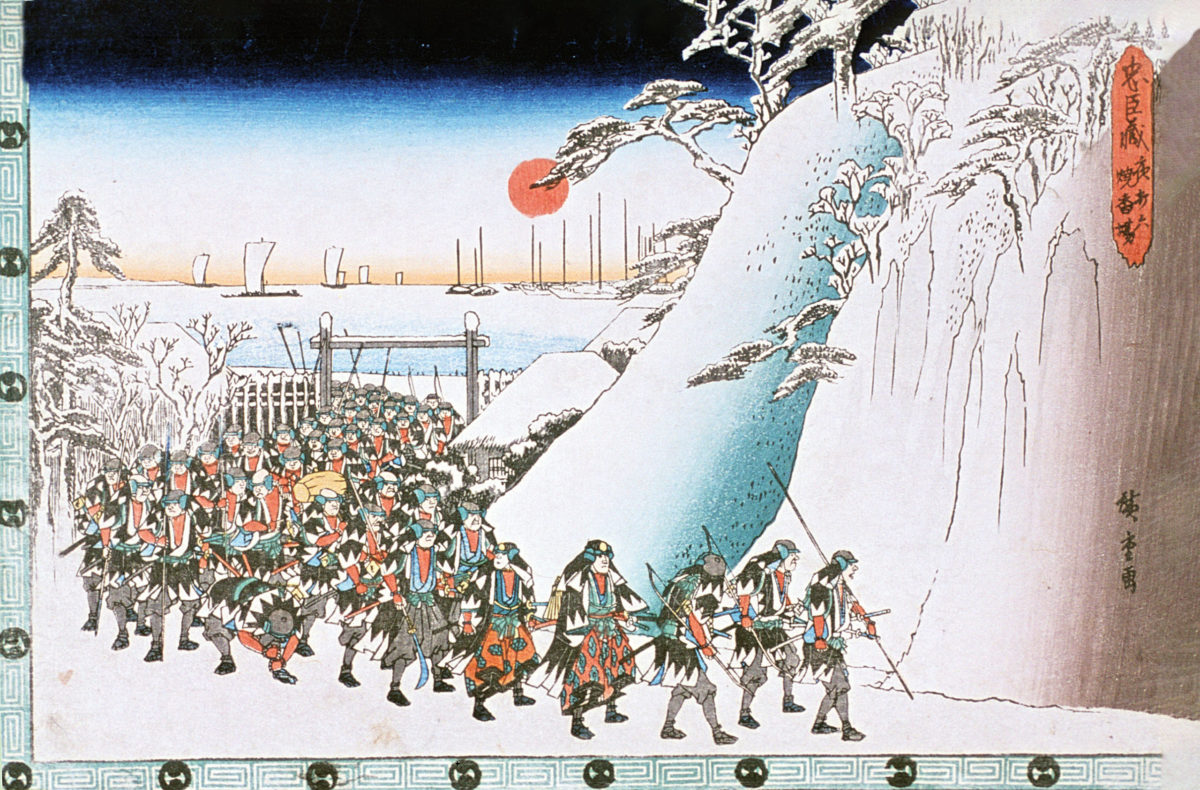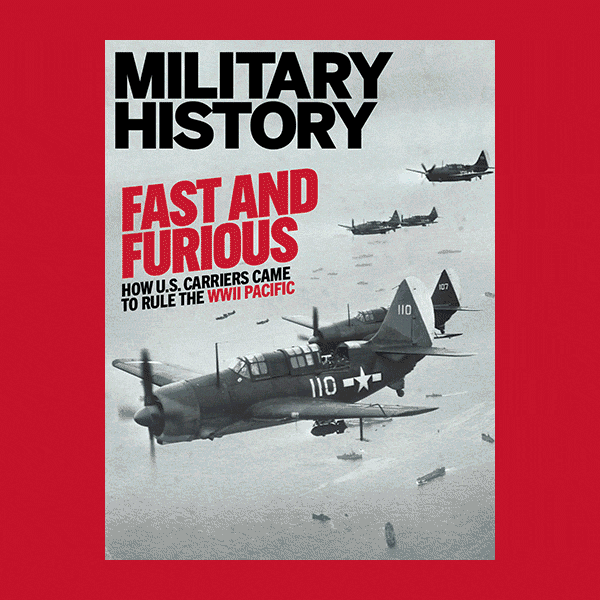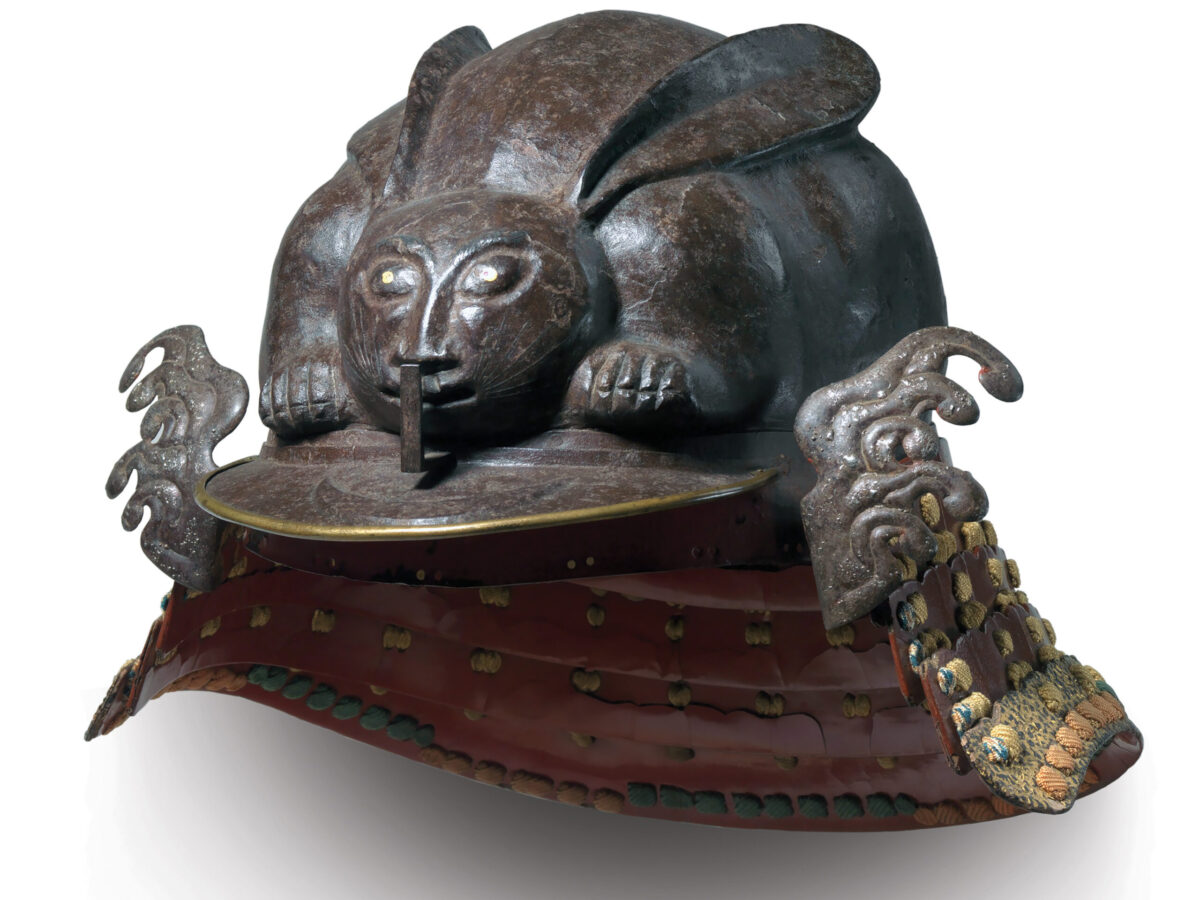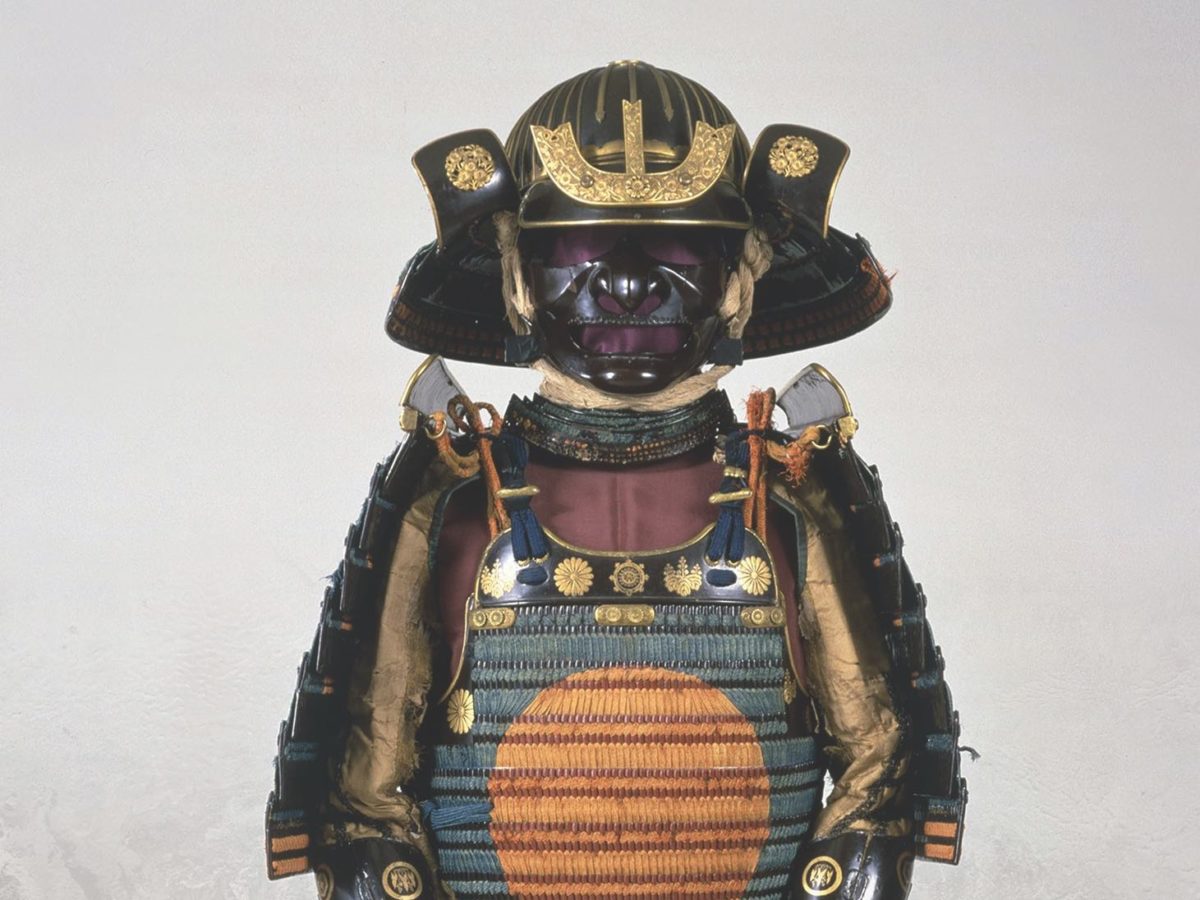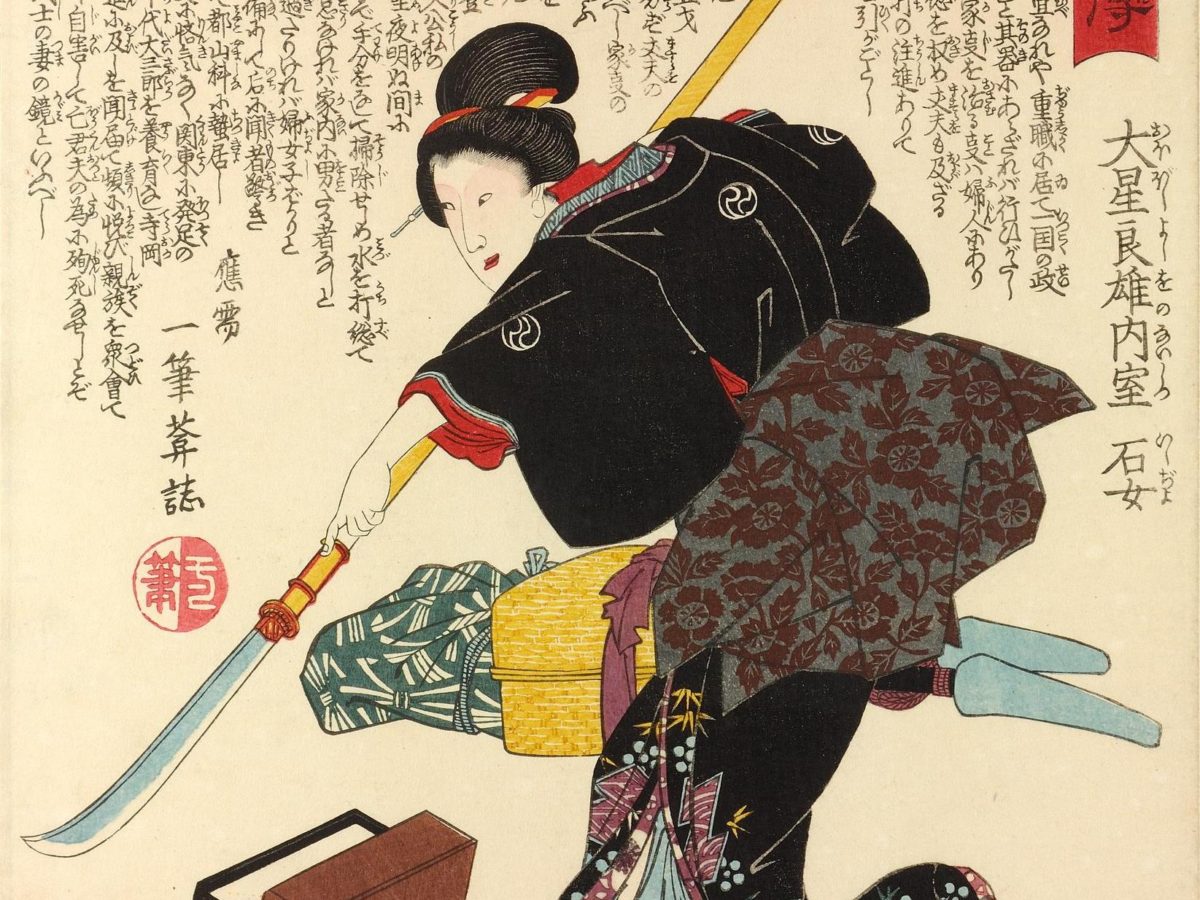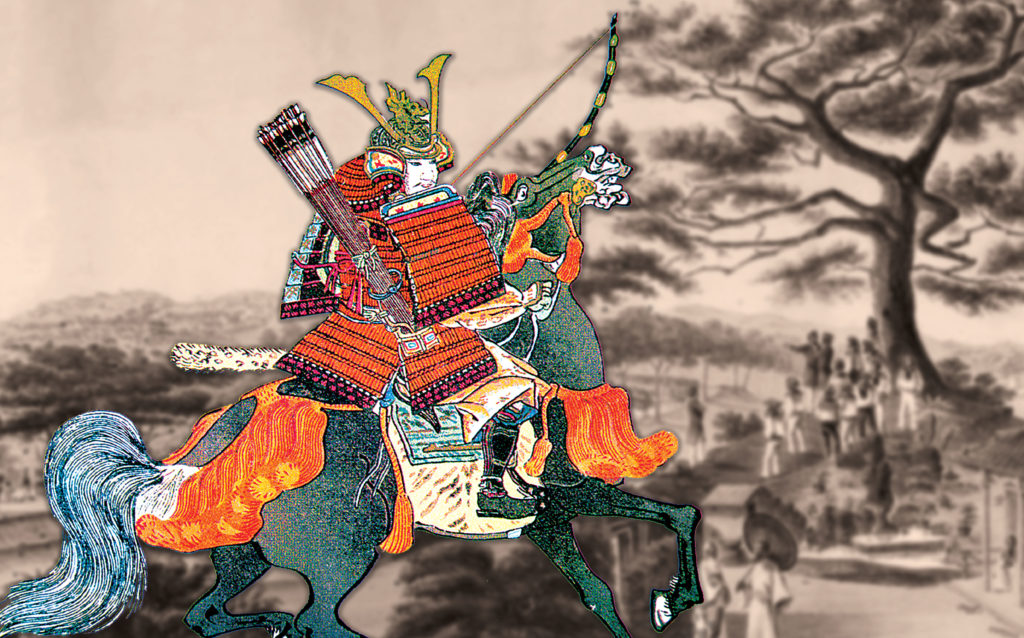Of all the weapons that man has developed since caveman days, few evoke such fascination as the samurai sword of Japan. To many of us in the West, the movie image of the samurai in his fantastic armor, galloping into battle on his horse, his colorful personal flag, or sashimono, whipping in the wind on his back, has become the very symbol of Japan, the Empire of the Rising Sun. And, truly, to the samurai of real life, nothing embodied his warrior’s code of Bushido more than his sword, considered inseparable from his soul.
Indeed, a sword was considered such a crucial part of a samurai’s life that when a young samurai was about to be born, a sword was brought into the bedchamber during the delivery. When the time came for an old samurai to die — and cross over into the ‘White Jade Pavilion of the Afterlife’ — his honored sword was placed by his side. Even after death, a daimyo, or nobleman, believed he could count on his samurai who had followed him into the next world to use their keen blades to guard him against any demons, just as they had wielded their trusty weapons to defend him against flesh-and-blood enemies in this life.
From the earliest recorded times, the exceptional quality of Japanese swords has made them prized and admired. The care and technical skill that went into the creation of a samurai sword made the finished product not only a noteworthy weapon of war but also a cherished work of art. When Japanese daimyos met, they would admire each other’s collection of fine swords. In 1586, when the great Japanese warlord Hideyoshi Toyotomi made peace with his archrival Ieyasu Tokugawa — making possible Toyotomi’s conquest of Japan — Toyotomi presented Tokugawa with a splendid sword to mark their newfound alliance. The sword was a work of rare beauty, accounts tell us, crafted by the inspired hands of the legendary Musumane, greatest of all Japanese swordsmiths. Masumane, ironically, rarely signed his work with his name, unlike his brother sword crafters. Ieyasu Tokugawa, meanwhile, became shogun, or military ruler, after Toyotomi’s death, founding a dynasty that would rule the country in peace for more than 250 years.
In a samurai family the swords were so revered that they were passed down from generation to generation, from father to son. If the hilt or scabbard wore out or broke, new ones would be fashioned for the all-important blade. The hilt, the tsuba (hand guard), and the scabbard themselves were often great art objects, with fittings sometimes of gold or silver. The hilt and scabbard were at times carved from ivory, just as Japanese statues often are today. Often, too, they ‘told’ a story from Japanese myths. Magnificent specimens of Japanese swords can be seen today in the Tokugawa Art Museum’s collection in Nagoya, Japan, many of which were exhibited during a tour of the United States in 1983 and 1984.
In creating the sword, a craftsman like Masumane had to surmount a virtual technological impossibility. The blade had to be forged so that it would hold a very sharp edge and yet not break in the ferocity of a duel. To achieve these twin objectives, the sword maker, or cutler, was faced with a considerable metallurgical challenge. Steel that is hard enough to take a sharp edge is brittle. Conversely, steel that will not break is considered soft steel and will not take a keen edge. Japanese sword artisans solved that dilemma in an ingenious way. Four metal bars — a soft iron bar to guard against the blade breaking, two hard iron bars to prevent bending and a steel bar to take a sharp cutting edge — were all heated at a high temperature, then hammered together into a long, rectangular bar that would become the sword blade. When the swordsmith ground the blade to sharpen it, the steel took the razor-sharp edge, while the softer metal ensured the blade would not break. This intricate forging process caused the wavy hamon, or ‘temper line,’ that is an important factor when sword connoisseurs judge a blade’s artistic merit.
So vital to the samurai spirit was the genesis of such a magnificent weapon that Shinto priests would be called in to bless the beginning of the process, and the swordsmith often underwent a spiritual purification before he began his work. In his Bushido: The Warrior’s Code, the best study in English of the samurai, Inazo Nitobe stated: ‘The swordsmith was not a mere artisan but an inspired artist and his workshop a sanctuary. Daily, he commenced his craft with prayer and purification, or, as the phrase was, ‘he committed his soul and spirit into the forging and tempering of the steel.”
Celebrated sword masters in the golden age of the samurai, roughly from the 13th to the 17th centuries, were indeed valued as highly as European artists such as Raphael, Michelangelo or Leonardo da Vinci. A sword creator who could almost match Masumane’s brilliance was fellow master craftsman Muramasa. The story is told of how a blade forged by Muramasa was held upright in a swiftly flowing stream and the edge effortlessly cut in two any dead leaf that the current brought against it. However, a blade made by Masumane was so sharp that, according to legend, when his blade was thrust into the water, the leaves actually avoided it!
By the time Ieyasu Tokugawa unified Japan under his rule at the Battle of Sekigahara in 1600, only samurai were permitted to wear the sword. A samurai was recognized by his carrying the feared daisho, the ‘big sword, little sword’ of the warrior. These were the battle katana, the ‘big sword,’ and the wakizashi, the ‘little sword.’ The name katana derives from two old Japanese written characters or symbols: kata, meaning’side,’ and na, or ‘edge.’ Thus a katana is a single-edged sword that has had few rivals in the annals of war, either in the East or the West.
The wakizashi, on the other hand, was even closer to a samurai’s soul than his katana. It was with the wakizashi that the bushi, or warrior, would take the head of an honored opponent after killing him. It was also with the wakizashi that a samurai would ritually disembowel himself in the act of seppuku, or hara-kiri, before his second (kaishaku) took off the samurai’s head to end the pain. (Suicide was performed by hara-kiri, or ‘belly-slitting,’ because the Japanese felt that the hara [intestines] were the seat of the emotions and the soul itself.) In the popular American television miniseries Shogun, based on the novel by James Clavell, the daimyo Kasigi Yabu, played by Japanese actor Frankie Sakai, committed suicide by hara-kiri when his treachery to his lord, Toronago (patterned after Ieyasu Tokugawa), was discovered. Sometimes a dagger, the aikuchi, was used for ritual suicide. The main difference between the aikuchi and another dagger, the tanto, was that the tanto possessed a hand guard (tsuba) and the aikuchi did not.
There were other types of swords as well in the time of the samurai. There was the tachi, similar to the katana and an exquisite weapon reserved for court and ceremonial occasions. (It most likely was a tachi that Hideyoshi Toyotomi actually presented to Tokugawa.) The nodachi, a long, wicked-looking katana carried slung over the warrior’s back, was a massive killing weapon like the two-handed sword hefted by the German landsknecht.
Recommended for you
Because the sword was the main battle weapon of Japan’s knightly man-at-arms (although spears and bows were also carried), an entire martial art grew up around learning how to use it. This was kenjutsu, the art of sword fighting, or kendo in its modern, non-warlike incarnation. The importance of studying kenjutsu and the other martial arts such as kyujutsu, the art of the bow, was so critical to the samurai — a very real matter of life or death — that Miyamoto Musashi, most renowned of all swordsmen, warned in his classic The Book of Five Rings: ‘The science of martial arts for warriors requires construction of various weapons and understanding the properties of the weapons. A member of a warrior family who does not learn to use weapons and understand the specific advantages of each weapon would seem to be somewhat uncultivated.’
Musashi, it should be noted, was famed for fighting with two swords at once.
There were many different ryus, or schools, offering the instruction of kenjutsu. The art of sword fighting, as with all the martial arts, had both a physical and a spiritual dimension. The physical aspect of the training was to acquire the proper techniques that governed everything from how to stand to how to gaze at the enemy. Educated by a master, or adept, the young samurai would learn the correct way to draw his sword and how to use it. As Tsunetomo Yamamoto put it in his Hagakure, written in 1716, ‘If you cut by standing firm and not missing the chance, you will do well.’ There were five basic blows used in kenjutsu, perpetuated today in kendo: from top to bottom; left to right; right to left; side to side; and a straight-ahead thrust aimed at the throat. As Musashi wrote, ‘If we know the path of the sword well, we can wield it easily.’
The education of a samurai was deeply colored by the religion of Zen Buddhism, which like much of Japanese culture originally was an importation from neighboring China. The goal of Zen, applied to the mastery of the sword, was to make a samurai’s thought and action instantaneous, at one and the same time. In The Zen Way to The Martial Arts, Zen master Taisen Deshimaru told the story of a samurai who had just made a pilgrimage to the shrine of Hachiman, the Japanese god of war, in Kamakura at the midnight hour. Leaving the sacred precincts, he sensed a monster hiding behind a tree, waiting to pounce on him. ‘Intuitively he drew his sword and slew it in the instant; the blood poured out and ran along the ground. He had killed it unconsciously….Intuition and action must spring forth at the same time.’
The goal, then, of striking without thinking was at the heart of instruction with the sword, because, as Deshimaru also related, in the deadly art of swordplay ‘there is no time for thinking, not even an instant.’ For a samurai to hesitate before striking, even for the time it takes to blink an eye, would give his opponent time to deal the mortal blow. The key to wielding a sword in a lightning stroke lay in emptying the mind of everything that did not have to do with studying the sword, a mental condition that can be called ‘no-mindedness,’ because the samurai is not holding anything in his mind except the task at hand. As the swordsman Yagyu Munemori, a contemporary of Musashi, commented, ‘The heart [of the samurai] is like a mirror, empty and clear.’
Once this state of mind was achieved, the warrior-to-be could become intent on learning the use of the sword with a single-minded concentration that was not possible in any other way. His mind cleared of any distractions, he could practice and practice until the wielding of the sword became second nature to him — intuition and action would indeed spring forth at the same instant, with deadly effect. The end result of such concentration and practice was a samurai’s ability to draw his sword and kill an enemy in one smooth movement called nukiuchi, just like a baseball player hitting the ball solidly every time he swings his bat.
The consequences of this education in kenjutsu were simply devastating — in a very real sense a revolution in warfare in the Far East. As early as the 12th century, the swordsmanship of the samurai was already the stuff of legends. In the Japanese epic, the Heiki Monogatari, written about the Gempei War that took place in the 1100s, a warrior-monk on the winning Minamoto side was heralded for using his sword, ‘wielding it in the zigzag style, the interlacing, cross, reversed dragonfly, waterwheel, and eight-sides-at-once styles of fencing…[to] cut down eight men.’
When two samurai faced off in a man-to-man duel, the climax was sharp and dramatic. In motion-picture director Akira Kurosawa’s The Seven Samurai, his best-known film in the United States, a master swordsman modeled on Musashi dispatches the other duelist with a single blow. Sometimes in real life, however, the finale would be catastrophic — the two contestants would draw and slash simultaneously, with both of them falling dead at the same moment.
Although there are no samurai duels fought in Japan today (except in samurai movies), the traditional sword fighting mentioned above is preserved in the martial arts sport of kendo, which also boasts enthusiasts outside Japan, including many living in the United States.
GET HISTORY’S GREATEST TALES—RIGHT IN YOUR INBOX
Subscribe to our HistoryNet Now! newsletter for the best of the past, delivered every Monday and Thursday.
Kendo in Japanese literally means ‘the way of the sword.’ Although centuries have passed since the golden age of the samurai, much remains in today’s kendo of the sword-fighting art of Japan’s redoubtable warriors. Training is done in armor resembling that worn by the medieval samurai. The shinai, the bamboo sword with which kendo devotees train, much resembles the dread katana, even to the protective tsuba. When the kendo student strikes home a blow with his shinai, he still roars from the depths of his hara, his soul, the ancient heart-stopping cry of ‘Kiai!‘ with which the samurai of old brought instant death with his sword.

